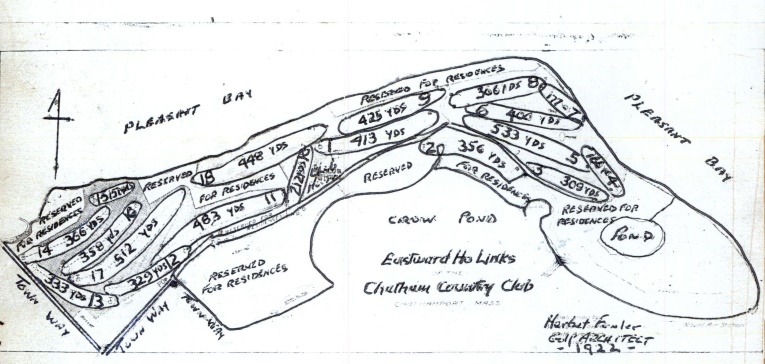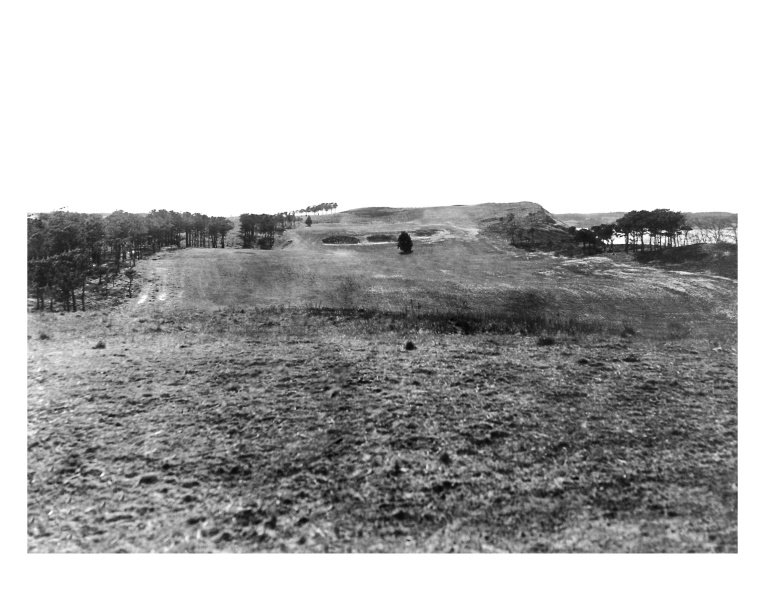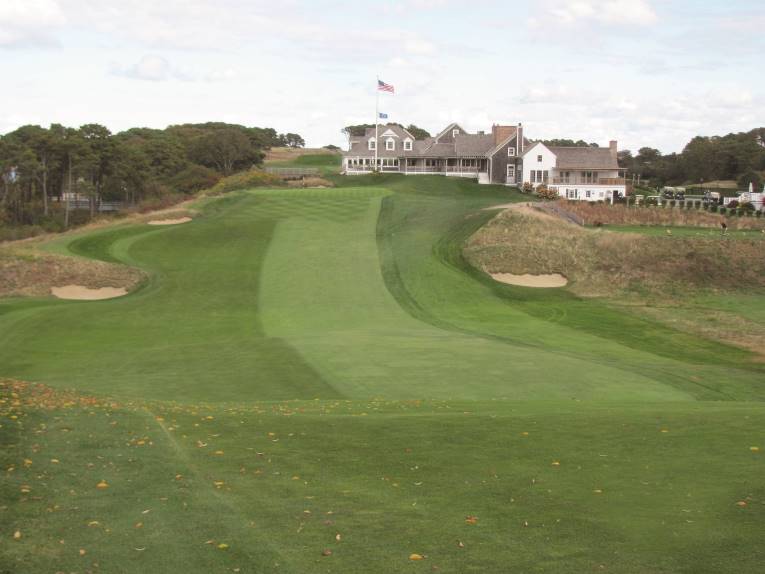Feature Interview
with
Bill Healy MD
January 2017
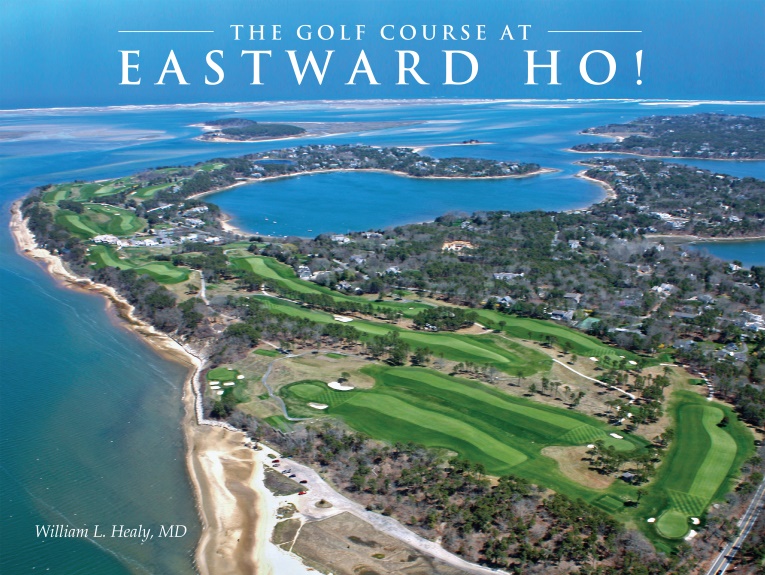
The inside of the book is as stunning as its cover photograph. The 13th, 14th and 16th holes are seen in the lower right corner.
Bill Healy MD is the author of The Golf Course at Eastward Ho!, which was released in August, 2016. Bill grew up in Boston and caddied at such fine courses as Charles River, Oyster Harbor and Needham. At Amherst College, he played football and rugby and later trained as an orthopedic surgeon at Johns Hopkins. He now practices Hip and Knee Replacement Surgery at Newton Wellesley Hospital and Massachusetts General Hospital. Bill is married to Angela C. Healy MD and they have four children and three grandchildren. The Golf Course at Eastward Ho! is sold through the professional shop at Eastward Ho! and is available to non-members by calling Brian Hamilton, PGA, on 508.945.0620.
1. I love your line in the Preface that “This book is a story of the golf course. It is not a comprehensive history of Eastward Ho!” What gave you the idea for what I consider to be a novel approach?
Thank you for noticing my focus on the golf course. It was intentional.
Golf clubs and golf courses all have stories, but they may not be the same story. Eastward Ho! has a long rich history as a golf club and as a social club. The club has provided members with golf, recreation, and social activities since 1922, and there is much information to collect in a club history. However, my interest in writing this book was the golf course.
My first round of golf at Eastward Ho! was in 1986, and I was mesmerized by the land, the design, and the golf holes. I had never seen, caddied on, or played a golf course like it. The experience was spectacular and memorable. At the time, I was a novice golfer, and my knowledge of golf course architecture was minimal. I did not understand golf course design; I did not understand the relationship of the land to design; and I knew little about strategic playing options and design. However, I did know that I wanted to play the golf course again, and eventually, I became interested in joining the club.
During the last three decades, I developed an interest in golf course design and architecture. I read books on golf design, I listened to golf course architects speak, I participated in symposiums and webinars on golf course architecture, and I visited many golf courses as part of a review or rating team.
This book began as an essay which I wrote for myself to test my evolving knowledge regarding golf course design. I did not start out with a plan to produce a 300 page book. When I shared my initial essay with a few friends, it was well received, and I decided to produce a book. When I met John Lucas, who agreed to design the book, we were clear from the outset that this would be a book about the golf course. As the project evolved, we included many aspects of club history in the book, but the primary focus was always on the golf course.
2. What did you hope to accomplish with this enormous undertaking?
This book was a hobby project—a labor of love, if you will. I wanted to tell the story of a great golf course. I also wanted to write an interesting and compelling book which presented the history, the land, and the design of the golf course at Eastward Ho!
3. As you highlight, Eastward Ho! is on a glacial landform that occupies 132 acres. Much of the front nine is located on the enticing – but narrow – Nickerson’s Neck peninsula. Talk to us about Fowler’s figure 8 routing and how you conclude that it ‘may be the strongest feature of the golf course.’
Routing a golf course is an artistic and scientific exercise. The architect aims to identify the best green sites, teeing grounds, and golf holes on a property while taking advantage of the terrain, natural features, existing drainage, scenic views, and wind to design interesting golf holes and to build an enjoyable and challenging golf course. In 1920, Herbert Fowler was familiar with many types of routing designs ranging from the narrow “out and in” consecutive hole design, which was prevalent on many links golf courses in Ireland and the UK, to the broader “fan design”, which was favored by Donald Ross at many golf and country clubs.
When Herbert Fowler visited Chatham in 1920, he encountered a small property with many acres of unplayable land. He was challenged to build a championship golf course on limited acreage, and he could not use all the land! The narrow Nickerson Neck peninsula presented him the opportunity to propose a classic “out and in” chain of golf holes with a clubhouse at the west end of the property. The front nine could have been routed west to east towards the sea, and the back nine could have been laid out east to west back towards the clubhouse. However, one of the first things Fowler determined during his initial survey of the land was that a clubhouse would be best situated in the center of the property with magnificent views of Pleasant Bay. He told the Founders that nine holes could be routed on the Atlantic Ocean side of the clubhouse, and nine holes could be routed on the inland side of the clubhouse.
The figure eight hourglass design allowed Fowler to incorporate features of the natural terrain (such as One, Six, Fourteen, Eighteen), place tees near greens to use the land efficiently (such as the junction of the third green and the fourth tee at the east end of the property and the adjacent thirteenth green and fourteenth tee at the west end of the property), design holes with and against with the prevailing and countervailing winds, and provide spectacular water views of Pleasant Bay, the Crows pond, and the Atlantic Ocean.
4. How did you discover that the founders initially contacted Willie Park Jr. and had him for a site visit?
The club has a letter from Willie Park Jr. to G. Herbert Windeler, one of the Founders Eastward Ho!, which documents Mr. Park’s visit to Chatham in October 1916. In this letter, Willie Park, Jr. wrote, “After going carefully over the land I am of the opinion it is admirably suited for this purpose. I should say it is one of the very best locations I have seen for the making of a Golf Course. There is good turf on most of the land, which could be worked up without ploughing and the soil is of the right kind……………I would say a course equal to, if not better, than any on this (U.S.A.) or the other side (Britain) could be made at very moderate cost.”
As a result of this favorable evaluation of the land by Willie Park, Jr., the club began to acquire land on Nickerson’s Neck in February 1917.
5. And just to confirm, there is no known evidence as to why Park or even indeed Donald Ross was not selected for the project once WWI ended?
Unfortunately, no. We are still looking for more information on the selection of the golf course designer. The only two golf course architects who are mentioned in club documents are Willie Park Jr. and W. Herbert Fowler.
Interestingly, since my book was printed, the club found an undated and unattributed sketch of a proposed golf course for Nickerson’s Neck at the Chatham Historical Society. This routing differs from Fowler’s design: the front nine is a clockwise loop beginning at the current ninth green and ending at the current first tee; Ten and Eleven are routed on the south side of the Town Road; and Twelve through Eighteen is a clockwise loop back to the first tee. This routing includes a central clubhouse near the first tee and the eighteenth green. We do not know who drew this sketch. Based on the timeline of Park’s visit, formation of the club, land acquisition, promotional material for prospective members, and Fowler’s initial visit, this sketch was probably created between late 1916 and early 1920 by Charles Ashley Hardy, G. Herbert Windeler, another member, a local golfer, or perhaps by Willie Park, Jr.
6. The founders were well traveled men, very accustomed to the delights of links golf in the United Kingdom. Is it fair to assume that helped contribute to the hiring of Herbert Fowler in 1920?
We do not know exactly why the Founders identified, selected, and hired Herbert Fowler to design their championship golf course on Cape Cod. Several of the Founders had visited the UK, and they played golf at Royal North Devon, Westward Ho! It seems likely that they learned of Herbert Fowler and his successful designs at Walton Heath (1903), Royal North Devon (1908), West Surrey (1910), and Woodcote Park (1915) during those trips.
We know that Willie Park, Jr. encountered health problems that may have precluded travel to Chatham when the club was ready to design and build the golf course. Perhaps Mr. Park suggested Mr. Fowler to the Founders?
We also know that in February 1920, Herbert Fowler opened an office for Fowler and Simpson Golf Architects in New York City and traveled to California before he headed back east to visit Chatham in May 1920.
7. Please share with us some of Fowler’s initial statements once he saw the land.
Herbert Fowler recorded his initial impressions of the land on Nickerson’s Neck in a letter to the Founders of the club on May 25, 1920. He was excited about the opportunity to design a championship golf course on this land and wrote, “I have carefully examined the ground which you have acquired for the purpose of making a golf course. I have seen very few pieces of ground to compare with this both as regards situation and the natural contours of the green. The situation is ideal and the scenic effect with the promontory running out into the sea is unique.”
Fowler also wrote, “There will be nothing approaching a bad hole, and I think you can safely reckon on at least twelve feature holes. I am quite aware that this is a very bold statement, but I make it with every confidence that it will be borne out by the future.”
8. How did he describe the opportunity when he next saw his friend Bernard Darwin in England?
After Herbert Fowler evaluated the land in Chatham and presented his thoughts to the Founders of the club, he returned to England for several months. While he was at home in the UK, he shared his thoughts about the “Cape Cod Project” with his friend, Bernard Darwin, who was the pre-eminent golf journalist of the time. Fowler wrote, “I am quite certain that I can design a course on this ground which will compare favorably with all but three or four courses in the United Kingdom and will be second to none of them.”
9. You make it quite clear that Fowler designed the course but that Charles Ashley Hardy deserves credit for overseeing the construction. Please explain.
Herbert Fowler deserves credit for designing and building the golf course at Eastward Ho! We have records of his visit in May 1920 to evaluate the land and design a routing for eighteen holes. We also have documentation of a Fowler visit to Chatham in May 1921 to monitor construction of the golf course and meet with prospective members. Herbert Fowler was a very busy man. He operated a golf architecture business on two continents. He served as Managing Director at Walton Health for almost forty years. He spent many summers at St. Andrews, and he was an active participant in the activities of the Green Committee of the R&A. Finally, he was committed to to his own golf game. In 1920, when he was 64 years old, he won the Franklin-Adams Golf Medal at Royal St. Georges! Unfortunately, we cannot validate more than two trips by Herbert Fowler to Cape Cod, so he must have had substantial assistance in the design and construction of the golf course at Eastward Ho!
Charles Ashley Hardy was an architect, stockbroker, and entrepreneur who lived in Boston and Chatham. Charles Hardy and several wealthy friends built the Chatham Bars Inn in 1912, and Hardy designed and built a nine hole golf course on the CBI property in 1913. Charles Hardy was one of the Founders of the club, which was called Great Point Golf Club, and he located the Nickerson’s Neck site for their championship golf course.
When Herbert Fowler returned to the UK in May 1920, Charles Ashley Hardy accompanied him on his trans-Atlantic trip and spent a few months with him in Surrey. We do not know what Hardy did while he was visiting Fowler in the UK, but we do know that when Hardy returned to Chatham, he supervised local workers who built the golf course at Eastward Ho! Charles Hardy documented his work building the golf course in an article titled “Efficiency in Golf Course Construction” which was published on October 17, 1921 in the Bulletin of the Green Section of the United States Golf Association.
In my opinion, Charles Ashley Hardy deserves considerable credit for building Herbert Fowler’s golf course design on Nickerson’s Neck, and I suspect several of the enduring features and subtle design strengths on the golf course accrue to Hardy.
10. Please tell us what you found on Fowler and blind shots!
Blind golf shots is an interesting topic which evokes diverse and divergent opinions from golfers and golf course architects. In general, I am not a fan of blind shots, but on land with topographical undulations and changes in elevation, like Nickerson’s Neck, blind shots cannot be avoided when routing eighteen holes. Donald Ross wrote, “On Undulating land, blind shots are bound to occur, and one or two of them are not at all serious. Truth be told, I rather like them, as they add a bit of spice to the game.”
At Eastward Ho!, blind shots can be encountered at 1, 2, 5, 6, 7, 8, 9, 10, 11, 12, 13, 14, 16, 17, and 18. When I researched Fowler’s thoughts on blind shots, I found a quote in an advertisement for the firm of Fowler & Simpson Golf Architects. “The better ‘ole is never a blind hole, it must be seen to be appreciated. Every contour and trap, almost every blade of grass can be seen before construction starts.”
When Herbert Fowler and Tom Simpson formed their partnership in the golf course design business, they used clay and plasticine models of their proposed golf courses as tools for selling their designs to clients. This quote clearly promotes the use of models to understand a proposed golf course design. In addition, I believe these words suggest that Fowler preferred that golfers could see the golf holes they are playing.
11. The course opened for play on July 3rd, 1922, well before the advent of the steel shaft. What did the course measure then and what does it measure now?
The Founders of Eastward Ho! intended to build a championship golf course on Cape Cod which would test the best golfers. We can assume that this goal pleased Herbert Fowler, who was chastised by several clubs and golf committees for designing long difficult golf courses which could only be played by elite golfers.
The original length of the golf course at Eastward Ho! was 6337 yards, which represented a stern test in 1922 given the golf equipment available. The length of the golf course from the tips in 2017 is 6437 yards. While 6437 yards may seem like a short pitch and putt golf course for elite golfers, the course plays longer than its measured yardage based on undulations on the playing surface, forced carries, and wind.
12. Armed with hickory clubs, Francis Ouimet was one of four to play an exhibition match on opening day. What length clubs did he hit into some of the holes and what were his comments afterwards?
On Opening Day, July 3, 1922, the club invited Francis Ouimet, a US Amateur and US Open champion to play in a 36 hole fourball match with three members. The Boston Herald covered the opening day festivities and reported on the match and the golf course. I do not know what distances Mr. Ouimet achieved with his hickory shaft golf clubs, but I do know that he was impressed with the difficulty of the golf course. Ouimet shot 84 and 82 on the new Eastward Ho! Golf Links, and he commented after the round, “Take it from me, it’s the hardest I ever tried to play on.” Ouimet also said that when the golf course matures, it will be among “the toughest of the tough in the way of scoring.”
Below is the 8th hole in Ouimet’s day …
13. You highlight how the logistical issues to get there were markedly different from today. Certain bridges didn’t exist, automobiles were wildly different, etc. To put it in perspective, how long did it take to get to the club from downtown Boston in ~1925?
In 2017, automobile travel time from Boston to Chatham is 90 to 120 minutes depending on traffic. Well maintained roads are available for the entire trip. Cars cross the Cape Cod Canal at the Sagamore Bridge (1935) and the Bourne Bridge (1935), which are fixed arch bridges with suspended decks.
I do not know the automobile travel time from Boston to Chatham in 1922, but it was much more than two hours. The 1920s was the Vintage Era of automobiles, and most cars were assuming front internal combustion engines, closed bodies, hydraulic brakes, and standardized controls. In spite of improved vehicles, automobile travel was not predictably reliable. Cars broke down frequently, road quality was inconsistent, and fuel availability varied by location. Furthermore, crossing the Cape Cod Canal in 1922 required the use of a narrow drawbridge which added time to the trip.
Limited access to Chatham probably played a role in the clubs failure to meet membership goals during the first few decades of existence.
14. You note the course measures 6,437 yards today. What allows it to still test the tiger at that length (and I ask that leading question because Brad Faxon told me that it was true!)?
The Founders of Eastward Ho! intended to build a difficult championship golf course. The golf course was difficult to play in 1922, and it is difficult to play in 2017. At 6337 yards in 1922, Eastward Ho! was a long golf course based on the golf clubs and golf balls available at the time. In fact, the difficult playability of the golf course was a barrier to recruiting members in the 1920s and 1930s.
At 6437 yards in 2017, Eastward Ho! is not long. However, Eastward Ho! remains a challenging golf course to play because of the undulating terrain, forced carries, and omnipresent coastal wind which make the golf course play longer than its measured yardage.
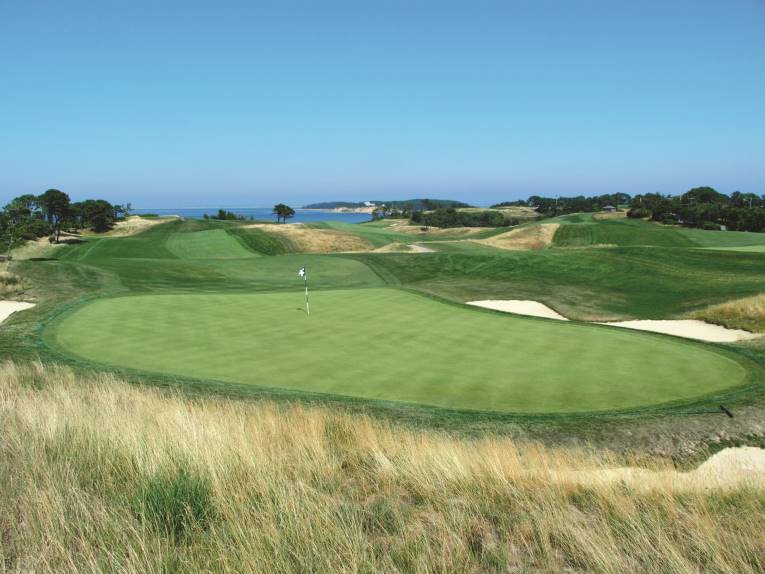
Eastward Ho! possesses some of the most rambunctious land in world golf. Whether your tee ball hits into the upslopes or downslopes varies day to day with the wind and greatly impacts how holes play. Above is a view across the 8th green and the front nine.
Eastward Ho! is a second shot golf course, and scoring well depends on more than length. Successful golf shots require accuracy and finesse. The relatively small greens (average size 4467 s.f.; range 3552 s.f. to 5523 s.f.) are located on challenging green complexes with difficult bunkers and tricky slopes. Golfers who wish to score well at Eastward Ho! must bring accuracy, finesse, and a strong short game.
15. You are right that the greens often times get overlooked as people understandably are drawn first to the tumbling land and long views. Let’s give them their due. What are some of the most vexing ones?
Great question! Green site selection and putting surface construction were very important to Herbert Fowler. In 1907, Fowler wrote, “Layers-out of courses should, I think, strive more to get suitable places for the various greens that to get the holes any particular length. Much can be done by judicious placing of the tees to get the desired length, but if the greens are badly placed the result will be that the holes will never command the respect of the good golfer”, and “It remains for the golf architect to so design the greens that they should be both difficult of access and that the putting shall demand care and skill in judging slopes and undulations.”
In 1922, Boston Herald sportswriter Larry Paton commented on the greens at Eastward Ho!, “Too exacting, I believe, are the greens. There is one way to play a green. Any other way is wrong, which is as it should be.” Fowler would have been proud of this evaluation of his work! The good news for Eastward Ho! is that Fowler and Hardy designed and built great greens and Foster and Hancock restored those great greens.
There are many greens to consider for “most vexing”, and I discussed this question with our golf professional, Brian Hamilton. In my opinion, the most difficult greens to putt at Eastward Ho! are Four and Seven, which are par three holes. Both of these greens are built on top of sand dunes fully exposed to wind and weather, and both greens slope considerably from back to front. They are difficult to hold with the tee shot, and they are difficult to putt based on the slopes, surface irregularities, speed, and wind—the breeze must be considered in planning and stroking all putts. The greens at Six, Eight, Ten, Eleven, Twelve, Fourteen, and Sixteen can also be difficult to putt based on pin position and wind.
However, no discussion of greens at Eastward Ho! should omit the green at One. The first green may be the most interesting green on the golf course, and frequently it is not given the respect it deserves—maybe because it is the opening hole. This seemingly natural putting surface sits on top of a sand dune with an open approach, a false front, a back to front tilt, slopes from right to center and left to center, and several surface elevations and depressions. One presents a challenging green to golfers, and it might be considered the “most vexing” putting surface on the golf course if it occurred later in the round.
16. The term ‘Nor’easter’ is well known beyond the confines of New England. Please share with us some notable weather events. What’s the most wind you have played in?
I love the wind at Eastward Ho! because it changes the golf course every day, and it frequently changes the golf course during a round. The prevailing southwest wind in summer is a gentle 5-10 mile an hour breeze which must be considered when planning and executing shots. However, the wind can kick up to a four or five club (30-40 mph) wind, and it can blow from the southwest, the east, the northeast, and the north on different days and during different seasons. The most impressive wind I have played in at Chatham was a five club breeze that blew in from the northeast with a rainstorm in the middle of our round—we should have quit and retired to the bar for a “relaxer”, but…………….
The most notable weather event that I recall at Eastward Ho! was the “No Name Storm” in October 1991. I was not a member of the club at the time. High winds damaged trees, and storm tides brought historic volumes of water into Pleasant Bay over several tide cycles. The water surge overwhelmed rock revetments and protective dunes to flood the golf course and create several memorable scenes. A pond formed at the lower fairway of Six, and it was populated by a slightly off course 22 foot trimaran! Furthermore, at one point during the storm there was a steady current of water from the Crows Pond to Pleasant Bay across Ten and Eighteen complete with a displaced navigation buoy.
17. What led to the hiring of Keith Foster in 2002 to develop a Master Plan for the restoration of the course?
In 1993, the Eastward Ho! Board of Governors assembled the Golf Course Long Range Planning Committee to develop a vision for the future of the golf course. In 2000, when the Golf Course Master Planning Process commenced, the club acknowledged that the golf course designed by Herbert Fowler in 1920 had changed significantly over eighty years. The master planning process culminated in restoration of the golf course in 2004 and subsequent improvements in 2007 and 2016.
Keith Foster, Golf Course Architect, was identified by the Board and the Green Committee for his commitment to designing and restoring classic traditional golf courses such as Colonial CC, Baltimore CC at Five Farms, Southern Hills, and Omaha CC. Keith was assisted in the restoration of the golf course by Frank Hancock, our Golf Course Superintendent.
18. What are three of the most important things that have been accomplished as part of that Master Plan?
As you know, a master planning process starts with the architect’s original design, reviews changes to the golf course over time, assesses the current state of the golf course, and proposes a plan for restoration of the golf course. The proposal includes recommendations from the consultant architect for improvement, and these suggestions range from strict restoration to new reconstruction concepts. Master planning processes are frequently more comprehensive on paper than on the golf course. Elements of master plans, which have been agreed to by consensus by committees and boards, can be tabled or left out of the work plan based on pushback from the club and cost. Some clubs prioritize the master plan work and plan to do the work in stages.
The master planning process at Eastward Ho! was comprehensive, and most of the planned work was completed in 2004. Mr. Foster was asked to restore the golf course at Eastward Ho! to Herbert Fowler’s original design and to create firm fast playing conditions consistent with a links golf course. Tees were to be resurfaced, realigned, reconfigured, and expanded. Playing corridors and fairways were to be reconstructed and widened to restore intended strategic options for play. Aeration of fairways, approaches, and greens with application of sand and topdressing was planned to create firm fast playing surfaces.
The elements of the golf course restoration at Eastward Ho! are listed on page 112 of the book. In my opinion, the most important aspects of the restoration were restoring the width of the fairways and playing corridors, reconstructing the bunkers, expanding and restoring the greens, and adding length. The golf course measured 6215 yards in 2003; it plays up to 6437 today and those 200+ yards are a subtle but important addition. Consistent with Fowler’s belief in the importance of greens to a golf course, the work on the greens was most impressive: approaches were firmed up, green shapes were expanded back to the borders of the original green pads, and the putting surfaces were improved with aeration, topdressing, and development of healthier grass.
19. Here is another shamelessly leading question. True or false: the set of one shotters at Eastward Ho! are now the best in the state.
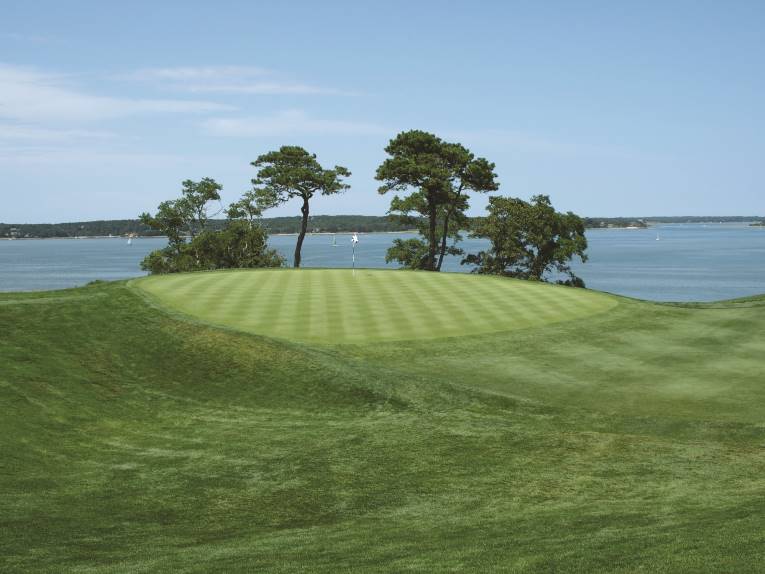
The none too big fourth green represents an elusive target, especially in any wind and played from the 182 yard tee.
True. In fact, the four par threes have been recognized for their natural brilliance since the beginning, when the golf course was called the Eastward Ho! Golf links. A strong argument for recognition of the four one shotters as the best in Massachusetts was written in 1922 by Larry Paton, a sportswriter for the Boston Herald. “The short holes at Eastward Ho! are ‘wonderful little critters’, to my mind, the fourth hole being the class of the four. It is 166 yards and both tee and green are at the edge of the sharp slope going down to the beach; and there is nothing but tee and green; with a ravine between and with the wind almost always inclined to carry the ball toward the water. Play that shot right or suffer the consequences. It is a spectacular little hole. The seventh hole, 177 yards, is made so much longer by the wind and by the elevated green that Ouimet and Estabrook took wooden clubs. The green of the tenth, 212 yards, looks from the tee like a narrow cut made through a hill by railroad builders. Shoot in the alley or pray. The last short one, the fifteenth, is 151 yards, with a double green, deep traps at the sides, and very bad rough beyond. The contours of the greens are not like anything else we have anywhere in Massachusetts. Most of them have little shallow, grassy depressions at the sides, so making approach putting an art.”
In 2017, the par three golf holes at Eastward Ho! continue to distinguish themselves. Three of them sit on the edge of Pleasant Bay with spectacular water views. They play to three different compass points and wind directions—Four and Seven play to the west, Ten plays to the south, and Fifteen plays to the east. The tee shots require precise shotmaking, the greens are hard to hold, and the putting surfaces are among the most challenging on the golf course.
I will be happy to defend the one shotters at Eastward Ho! against any par three cohort in the Commonwealth.
20. Nearly half of the 300+ page book is devoted to a hole by hole description. Please describe a favorite par 3, par 4 and par 5.
As you acknowledge, the par threes at Eastward Ho! are all terrific, but my favorite short hole is Fifteen. I like everything about this golf hole. I like selecting my club and thinking about the distance to the pin, the placement of the pin on the green, the slight uphill nature of the shot, the four bunkers surrounding the green, and the hazard of Pleasant bay along the entire left side of the green. Assessment of the the intensity and the direction wind is essential—the direction of the boats moored in the bay tell us the direction of the wind. I like the way the hole sets up for my right to left ball flight. I like the challenge of hitting the green, which is the only green on the golf course which requires a forced carry to reach the putting surface. I do not like playing out of the six bunkers on the hole, but I like the positioning and design of the bunkers. I do not like yanking my tee shot into Pleasant Bay, but the water sure is beautiful. Finally, I like putting on the three tier putting surface which slopes from back to front. Each tier has high and low spots which affect the roll of the ball, and as usual at Eastward Ho! the best and easiest putts are from below the hole.
It is difficult for me to pick a favorite par four among One, Three, Six, Eight, Twelve, Sixteen, and Eighteen, but I will choose the first hole for this exercise. One is a terrific golf hole which would garner more respect if it were not the opening hole on the golf course. I like the location of the teeing ground in front of the clubhouse and adjacent to the putting green which renders the first drive of the day wide open to public scrutiny. I like the tee shot which requires length and accuracy to reach a favorable landing spot which sets up the approach shot. I like the uphill approach shot over the central crater bunker and the right side approach bunker. I like the option of flying the approach shot all the way to the green or running the approach shot up the hill to the green. I like the open approach to the green, the false front, and the many irregularities of the putting surface which make putting at One fun. I like the looking back at One down towards the clubhouse, and I love the fact that after I play One, I have seventeen more great golf holes to play.
The three par five golf holes are among the less distinguished holes on the golf course, and each has features which I could extoll or criticize. So…….let’s pick Seventeen as my favorite. Seventeen may not be as strong a golf hole as Five or Eleven, but I enjoy playing Seventeen. I like the forgiving tee shot, which is a grip it and rip it moment—length can be helpful. The fairway is wide, Cahoon’s Hollow on the right will allow birdie or par, and the trees/fescue area on the left generally allows finding the ball and a recovery shot. I like the planning and execution of the second shot which can be a heroic whack towards the green or a strategic play to set up the approach shot. I like the Fowler fairway bunker on the right side at about 150 yards from the green. I like the relatively flat lies in the deep hollow on the left side of the fairway about 100 yards from the green. I like the option of flying the approach shot to the putting surface or running the ball down the right side to roll onto the green—I have been known to putt onto the green from fifty yards! I like the irregular circular shape of the green and the shallow bowl configuration of the putting surface which looks like a catcher’s mitt. I like the subtle breaks on this green which are not obvious. I like Seventeen because it is a fun hole to play.
21. How/where did you gather the neatest bits of information and/or any unexpected sources that provided vital information. After all, the book represents incredible research.
From 2009 through 2015, I tried to read every document that the club has in its possession. I opened every box I could find in the office, the storerooms, and the basement. I asked Brian Hamilton, the Golf Professional, Frank Hancock, the Golf Course Superintendent, and John Dufault, the Clubhouse Manager to give me everything they had regarding the golf course past or present. I read every newsletter I could find from 1922 to the present. I read the minutes of every meeting of the Board of Governors and the Executive Committee from the 1920s to the present. I learned a lot from Luis Fernandez-Herlihy MD who wrote a book on the history of Nickerson’s Neck. I read as much as I could find on the life and golf course design work of W. Herbert Fowler. I wrote a rough draft or first edition of this book in 2012, and I distributed it to many friends and colleagues who gave me important and insightful constructive comments which improved my original work.
Well, it all worked as the book does a phenomenal job of capturing a spectacular course – Congratulations!
To reiterate, The Golf Course at Eastward Ho! is available to non-members by calling Brian Hamilton, PGA, at the Eastward Ho! golf shop on 508.945.0620.


